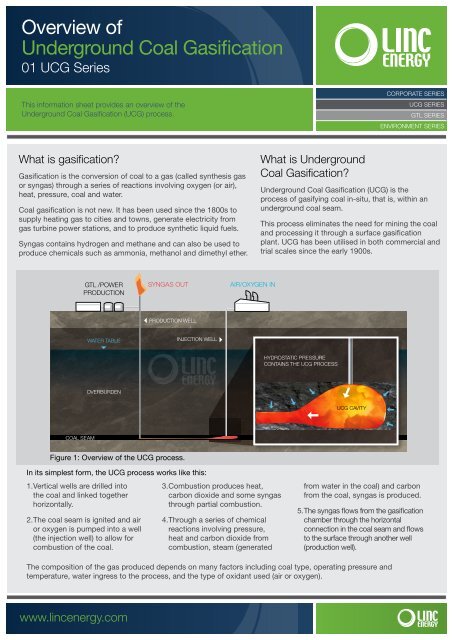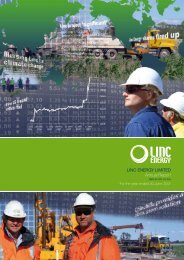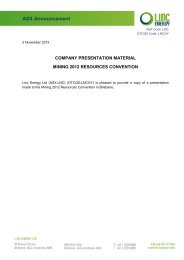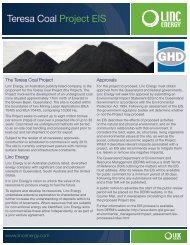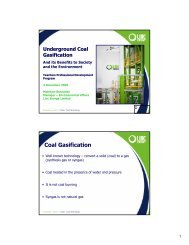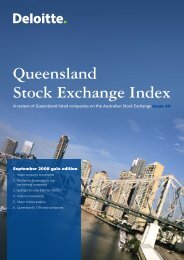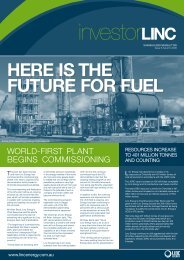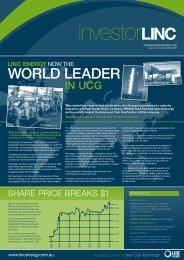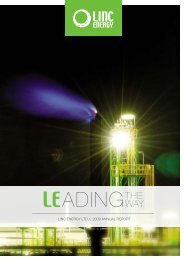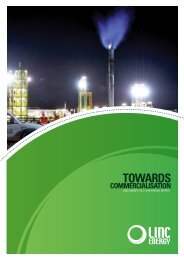Overview of Underground Coal Gasification - Linc Energy
Overview of Underground Coal Gasification - Linc Energy
Overview of Underground Coal Gasification - Linc Energy
Create successful ePaper yourself
Turn your PDF publications into a flip-book with our unique Google optimized e-Paper software.
<strong>Overview</strong> <strong>of</strong><br />
<strong>Underground</strong> <strong>Coal</strong> <strong>Gasification</strong><br />
01 UCG Series<br />
This information sheet provides an overview <strong>of</strong> the<br />
<strong>Underground</strong> <strong>Coal</strong> <strong>Gasification</strong> (UCG) process.<br />
CORPORATE SERIES<br />
UCG SERIES<br />
GTL SERIES<br />
ENVIRONMENT SERIES<br />
What is gasification<br />
<strong>Gasification</strong> is the conversion <strong>of</strong> coal to a gas (called synthesis gas<br />
or syngas) through a series <strong>of</strong> reactions involving oxygen (or air),<br />
heat, pressure, coal and water.<br />
<strong>Coal</strong> gasification is not new. It has been used since the 1800s to<br />
supply heating gas to cities and towns, generate electricity from<br />
gas turbine power stations, and to produce synthetic liquid fuels.<br />
Syngas contains hydrogen and methane and can also be used to<br />
produce chemicals such as ammonia, methanol and dimethyl ether.<br />
What is <strong>Underground</strong><br />
<strong>Coal</strong> <strong>Gasification</strong><br />
<strong>Underground</strong> <strong>Coal</strong> <strong>Gasification</strong> (UCG) is the<br />
process <strong>of</strong> gasifying coal in-situ, that is, within an<br />
underground coal seam.<br />
This process eliminates the need for mining the coal<br />
and processing it through a surface gasification<br />
plant. UCG has been utilised in both commercial and<br />
trial scales since the early 1900s.<br />
GTL /POWER<br />
PRODUCTION<br />
SYNGAS OUT<br />
AIR/OXYGEN IN<br />
PRODUCTION WELL<br />
WATER TABLE<br />
INJECTION WELL<br />
HYDROSTATIC PRESSURE<br />
CONTAINS THE UCG PROCESS<br />
OVERBURDEN<br />
UCG CAVITY<br />
COAL SEAM<br />
Figure 1: <strong>Overview</strong> <strong>of</strong> the UCG process.<br />
In its simplest form, the UCG process works like this:<br />
1. Vertical wells are drilled into<br />
the coal and linked together<br />
horizontally.<br />
2. The coal seam is ignited and air<br />
or oxygen is pumped into a well<br />
(the injection well) to allow for<br />
combustion <strong>of</strong> the coal.<br />
3. Combustion produces heat,<br />
carbon dioxide and some syngas<br />
through partial combustion.<br />
4. Through a series <strong>of</strong> chemical<br />
reactions involving pressure,<br />
heat and carbon dioxide from<br />
combustion, steam (generated<br />
from water in the coal) and carbon<br />
from the coal, syngas is produced.<br />
5. The syngas flows from the gasification<br />
chamber through the horizontal<br />
connection in the coal seam and flows<br />
to the surface through another well<br />
(production well).<br />
The composition <strong>of</strong> the gas produced depends on many factors including coal type, operating pressure and<br />
temperature, water ingress to the process, and the type <strong>of</strong> oxidant used (air or oxygen).<br />
www.lincenergy.com
<strong>Overview</strong> <strong>of</strong> <strong>Underground</strong> <strong>Coal</strong> <strong>Gasification</strong><br />
01 UCG Series<br />
Benefits <strong>of</strong> UCG<br />
UCG <strong>of</strong>fers the potential to use the<br />
energy stored in coal deposits that are<br />
uneconomic to mine by conventional<br />
methods. The use <strong>of</strong> UCG could<br />
potentially increase global coal<br />
reserves from 900 billion tonnes to<br />
1.5 trillion tonnes 1 .<br />
Other benefits <strong>of</strong> UCG include:<br />
• No need to mine the coal or build a<br />
surface plant for gasification<br />
• Elimination <strong>of</strong> the safety hazards<br />
associated with underground<br />
coal mining<br />
• The syngas product can be used<br />
in a variety <strong>of</strong> industrial processes<br />
including power generation,<br />
liquid fuel production and<br />
chemical manufacture<br />
• Significant environmental<br />
benefits, such as reduced surface<br />
disturbance and land use conflicts<br />
(compared with coal mining and<br />
oil and gas operations), avoidance<br />
<strong>of</strong> greenhouse gas production<br />
associated with coal mining and a<br />
relatively small physical footprint for<br />
large amounts <strong>of</strong> energy extraction.<br />
UCG technology could also be<br />
regarded as an enabling technology<br />
for carbon capture since it has the<br />
ability to deliver an enriched CO 2<br />
stream suitable for carbon capture<br />
and storage. For example if the<br />
syngas is to be used as a feedstock<br />
for a GTL process, then the<br />
sequestration <strong>of</strong> CO 2<br />
from the gas is<br />
a necessary step in the process.<br />
• With an approximate 21 per cent<br />
reduction in greenhouse gas<br />
emissions, 2,3 UCG is a lower carbon<br />
emitting technology 4 for power<br />
generation (compared to coal-fired<br />
power stations)<br />
What makes<br />
<strong>Linc</strong> <strong>Energy</strong> different<br />
<strong>Linc</strong> <strong>Energy</strong> is striving to be the first<br />
company to commercially produce<br />
high quality synthetic liquid fuels using<br />
syngas produced from UCG.<br />
All other operations around the world<br />
that use syngas to produce liquid fuel<br />
rely on mining the coal and gasifying<br />
it through surface plants.<br />
<strong>Linc</strong> <strong>Energy</strong> is pursuing a lower cost,<br />
lower environmental impact solution<br />
for alternative fuel production by<br />
combining two proven technologies.<br />
1 World <strong>Energy</strong> Council, 2007.<br />
2 Life cycle emissions compared to the most efficient pulverised<br />
fuel supercritical Australian coal-fired power stations using<br />
mined coal. Not including sequestration.<br />
3 BHP Billiton, 2002. Case Study B20: Electricity Production<br />
Using <strong>Underground</strong> <strong>Coal</strong> <strong>Gasification</strong> (UCG). Newcastle,<br />
Australia.<br />
4 UCG, when used for power generation, is a clean coal<br />
technology by definition. Clean <strong>Coal</strong> Technology Special<br />
Agreement Act 2007 (Qld): Clean <strong>Coal</strong> Technologies means<br />
“technologies that have potential to facilitate substantial<br />
reduction <strong>of</strong> emissions <strong>of</strong> Greenhouse Gas to the atmosphere<br />
from the use <strong>of</strong> coal”.<br />
About <strong>Linc</strong> <strong>Energy</strong><br />
<strong>Linc</strong> <strong>Energy</strong> is a globally focused,<br />
diversified energy company with a<br />
strong portfolio <strong>of</strong> coal, oil and gas<br />
deposits. <strong>Linc</strong> <strong>Energy</strong>’s purpose is<br />
to unlock the value <strong>of</strong> its resources<br />
to produce energy to fuel the future.<br />
A public company, <strong>Linc</strong> <strong>Energy</strong> is<br />
the global leader in UCG, delivering<br />
synthesis gas for commercially viable<br />
energy solutions (electricity, transport<br />
fuels and oil production), via gas turbine<br />
combined cycle power generation,<br />
Gas to Liquids processing and<br />
Enhanced Oil Recovery.<br />
Related information sheets<br />
UCG Explained<br />
UCG, GTL and the Environment<br />
Modern UCG Practices<br />
AUSTRALIAN HEAD OFFICE<br />
32 Edward Street<br />
GPO Box 1315<br />
Brisbane QLD 4001<br />
AUSTRALIA<br />
p +61 7 3229 0800<br />
f +61 7 3229 6800<br />
UNITED STATES HEAD OFFICE<br />
1200 17th Street<br />
Suite 2100<br />
Denver CO 80202<br />
UNITED STATES<br />
p +11 303 623 0510<br />
f +11 303 623 0547<br />
linc@lincenergy.com<br />
www.lincenergy.com<br />
Important disclaimer: Information contained in this information sheet is provided for information only and <strong>Linc</strong> <strong>Energy</strong> makes no warranties as to its accuracy and completeness. Use <strong>of</strong> information contained in this information sheet is at the sole risk<br />
<strong>of</strong> the user. <strong>Linc</strong> <strong>Energy</strong> has made reasonable efforts to ensure that information in this information sheet is accurate at the time <strong>of</strong> its compilation, however there may be inadvertent errors or omissions for which <strong>Linc</strong> <strong>Energy</strong> apologises. To the extent<br />
permitted by law, <strong>Linc</strong> <strong>Energy</strong> accepts no responsibility for any loss, damage, cost or expense whatsoever incurred by any person as a result <strong>of</strong> any use <strong>of</strong> or error or omission in or relating to, the information contained in this information sheet.<br />
LINC-UCG-01.2


